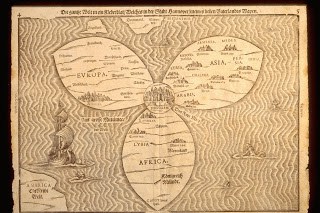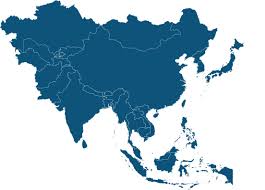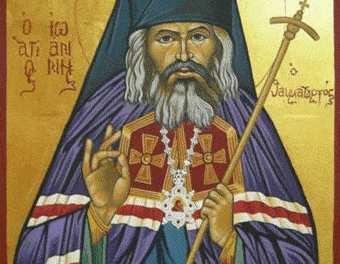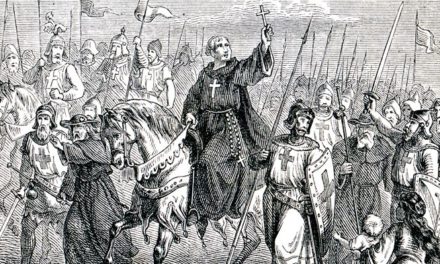This episode of Communio Santorum is titled, “And In the East – Part 1.”
The 5th C Church Father Jerome wrote, “[Jesus] was present in all places with Thomas in India, with Peter in Rome, with Paul in Illyria, with Titus in Crete, with Andrew in Greece, with each apostle . . . in his own separate region.”
So far we’ve been following the track of most western studies of history, both secular & religious, by concentrating on what took place in the West & Roman Empire. Even though we’ve delved briefly into the Eastern Roman Empire, as Lars Brownworth aptly reminds us in his outstanding podcast, 12 Byzantine Emperors, even after the West fell in the 5th Century, the Eastern Empire continued to think of & call itself Roman. It’s later historians who refer to it as the Byzantine Empire.
Recently we’ve seen the focus of attention shift to the East with the Christological controversies of the 4th & 5th Cs. In this episode, we’ll stay in the East and follow the track of the expansion of the Faith as it moved Eastward. This is an amazing chapter often neglected in traditional treatments of church history. It’s well captured by Philip Jenkins in his book, The Lost History of Christianity.
We start all the way back at the beginning with the apostle Thomas. He’s linked by pretty solid tradition to the spread of Christianity into the East. In the quote we started with from the early 5th C Church Father Jerome, we learn that the Apostle Thomas carried the Gospel East all the way to India.
In the early 4th C, Eusebius also attributed the expansion of the faith in India to Thomas. Though these traditions do face some dispute, there are still so-called ‘Thomas Christians’ in the southern Indian state of Kerala today. They use an Aramaic form of worship that had to have been transported there very early. A tomb & shrine in honor of Thomas at Mylapore is built of bricks used by a Roman trading colony but was abandoned after ad 50. There’s abundant evidence of several Roman trading colonies along the coast of India, with hundreds of 1st C coins & ample evidence of Jewish communities. Jews were known to be a significant part of Roman trade ventures. Their communities were prime stopping places for the efforts of Christian missionaries as they followed the Apostle Paul’s model as described in the Book of Acts.
A song commemorating Thomas’ role in bringing the faith to India, wasn’t committed to writing till 1601 but was said to have been passed on in Kerala for 50 generations. Many trading vessels sailed to India in the 1st C when the secret of the monsoon winds was finally discovered, so it’s quite possible Thomas did indeed make the journey. Once the monsoons were finally figured out, over 100 trade ships a year crossed from the Red Sea to India.
Jesus told the disciples to take the Gospel to the ends of the Earth. While they were slow to catch on to the need to leave Jerusalem, persecution eventually convinced them to get moving. It’s not hard to imagine Thomas considering a voyage to India as a way to literally fulfill the command of Christ. India would have seemed the end of the Earth.
Thomas’s work in India began in the northwest region of the country. A 4th C work called The Acts of Thomas says that he led a ruler there named Gundafor to faith. That story was rejected by most scholars & critics until an inscription was discovered in 1890 along with some coins which verify the 20-year reign in the 1st C of a King Gundafor.
After planting the church in the North, Thomas traveled by ship to the Malabar Coast in the South. He planted several churches, mainly along the Periyar River. He preached to all classes of people and had about 17,000 converts from all Indian castes. Stone crosses were erected at the places where churches were founded, and they became centers for pilgrimages. Thomas was careful to appoint local leadership for the churches he founded.
He then traveled overland to the Southeast Indian coast & the area around Madras. Another local king and many of his subjects were converted. But the Brahmins, highest of the Indian castes, were concerned the Gospel would undermine a cultural system that was to their advantage, so they convinced the king at Mylapore, to arrest & interrogate him. Thomas was sentenced to death & executed in AD 72. The church in that area then came under persecution and many Christians fled for refuge to Kerala.
A hundred years later, according to both Eusebius & Jerome, a theologian from the great school at Alexandria named Pantaenus, traveled to India to “preach Christ to the Brahmins.”[1]
Serving to confirm Thomas’ work in India is the writing of Bar-Daisan. At the opening of the 3rd Century, he spoke of entire tribes following Jesus in North India who claimed to have been converted by Thomas. They had numerous books and relics to prove it. By AD 226 there were bishops of the Church in the East in northwest India, Afghanistan & Baluchistan, with thousands of laymen and clergy engaging in missionary activity. Such a well-established Christian community means the presence of the Faith there for the previous several decades at the least.
The first church historian, Eusebius of Caesarea, to whom we owe so much of our information about the early Church, attributed to Thomas the spread of the Gospel to the East. As those familiar with the history of the Roman Empire know, the Romans faced continuous grief in the East by one Persian group after another. Their contest with the Parthians & Sassanids is a thing of legend. The buffer zone between the Romans & Persians was called Osrhoene with its capital city of Edessa, located at the border of what today is northern Syria & eastern Turkey. According to Eusebius, Thomas received a request from Abgar, king of Edessa, for healing & responded by sending Thaddaeus, one of the disciples mentioned in Luke 10.[2] Thus, the Gospel took root there. There was a sizeable Jewish community in Edessa from which the Gospel made several converts. Word got back to Israel of the Church community growing in the city & when persecution broke out in the Roman Empire, many refugees made their way East to settle in a place that welcomed them.
Edessa became a center of the Syrian-speaking church which began sending missionaries East into Mesopotamia, North into Persia, Central Asia, then even further eastward. The missionary Mari managed to plant a church in the Persian capital of Ctesiphon, which became a center of missionary outreach in its own right.
By the late 2nd C, Christianity had spread throughout Media, Persia, Parthia, and Bactria. The 2 dozen bishops who oversaw the region carried out their ministry more as itinerant missionaries than by staying in a single city and church. They were what we refer to as tent-makers; earning their way as merchants & craftsmen as they shared the Faith where ever they went.
By AD 280 the churches of Mesopotamia & Persia adopted the title of “Catholic” to acknowledge their unity with the Western church during the last days of persecution by the Roman Emperors. In 424 the Mesopotamian church held a council at the city of Ctesiphon where they elected their first lead bishop to have jurisdiction over the whole Church of the East, including India & Ceylon, known today as Sri Lanka. Ctesiphon was an important point on the East-West trade routes which extended to India, China, Java, & Japan.
The shift of ecclesiastical authority was away from Edessa, which in 216 became a tributary of Rome. The establishment of an independent patriarchate contributed to a more favorable attitude by the Persians, who no longer had to fear an alliance with the hated Romans.
To the west of Persia was the ancient kingdom of Armenia, which had been a political football between the Persians & Romans for generations. Both the Persians & Romans used Armenia as a place to try out new diplomatic maneuvers with each other. The poor Armenians just wanted to be left alone, but that was not to be, given their location between the two empires. Armenia has the historical distinction of being the first state to embrace Christianity as a national religion, even before the conversion of Constantine the Great in the early 4th C.
The one who brought the Gospel to Armenia was a member of the royal family named Gregory, called “the Illuminator.” While still a boy, Gregory’s family was exiled from Armenia to Cappadocia when his father was thought to have been part of a plot to assassinate the King. As a grown man who’d become a Christian, Gregory returned to Armenia where he shared the Faith with King Tiridates who ruled at the dawn of the 4th C. Tiridates was converted & Gregory’s son succeeded him as bishop of the new Armenian church. This son attended the Council of Nicea in 325. Armenian Christianity has remained a distinctive and important brand of the Faith, with 5 million still professing allegiance to the Armenian Church.[3]
Though persecution came to an official end in the Roman Empire with Constantine’s Edict of Toleration in 313, it BEGAN for the church in Persia in 340. The primary cause for persecution was political. When Rome became Christian, its old enemy turned anti-Christian. Up to that point, the situation had been reversed. For the first 300 hundred years, it was in the West Christians were persecuted & Persia was a refuge. The Parthians were religiously tolerant while their less tolerant Sassanid successors were too busy fighting Rome to waste time or effort on the Christians among them.
But in 315 a letter from Constantine to his Persian counterpart Shapur II triggered the beginnings of an ominous change in the Persian attitude toward Christians. Constantine believed he was writing to help his fellow believers in Persia but succeeded only in exposing them. He wrote to the young Persian ruler: “I rejoice to hear that the fairest provinces of Persia are adorned with Christians. Since you are so powerful and pious, I commend them to your care, and leave them in your protection.”
The schemes & intrigues that had flowed for generations between Rome & the Persians were so intense this letter moved Shapur to become suspicious the Christians were a kind of 5th column, working from inside the Empire to bring the Sassanids down. Any doubts were dispelled 20 years later when Constantine gathered his forces in the East for war. Eusebius says Roman bishops accompanied the army into battle. To make matters worse, in Persia, one of their own preachers predicted Rome would defeat the Sassanids.
Little wonder then, when persecution began shortly after, the first accusation brought against Christians was that they aided the enemy. Shapur ordered a double taxation on Christians & held their bishop responsible for collecting it. Shapur knew Christians tended to be poor since so many had come from the West fleeing persecution, so the bishop would be hard-pressed to come up w/the money. But Bishop Simon refused to be intimidated. He declared the tax unjust and said, “I’m no tax collector! I’m a shepherd of the Lord’s flock.” Shapur counter-declared the church was in rebellion & the killings began.
A 2nd decree ordered the destruction of churches and the execution of clergy who refused to participate in the official Sassanid-sponsored sun-worship. Bishop Simon was seized & brought before Shapur. Offered a huge bribe to capitulate, he refused. The Persians promised if he alone would renounce Christ, the rest of the Christian community wouldn’t be harmed, but that if he refused he’d be condemning all Christians to destruction. When the Christians heard of this, they rose up, protesting en masse that this was shameful. So Bishop Simon & a large number of the clergy were executed.
For the next 20 years, Christians were hunted down from one end of Persia to the other. At times it was a general massacre. But more often it was organized elimination of the church’s leaders.
Another form of suppression was the search for that part of the Christian community that was most vulnerable to persecution; Persians who’d converted from Zoroastrianism. The faith spread first among non-Persians in the population, especially Jews & Syrians. But by the beginning of the 4th C, Persians in increasing numbers were attracted to the Christian faith. For such converts, church membership often meant the loss of everything – family, property rights, even life.
The martyrdom of Bishop Simon and the years of persecution that followed gutted the Persian church of its leadership & organization. As soon as the Christians of Ctesiphon elected a new bishop, he was seized & killed. Adding to the anti-Roman motivation of the government’s role in the persecutions was a deep undercurrent of Zoroastrian fanaticism that came as a result of the conversion of so many of their number to Christianity; it was a shocking example of religious envy.
Shortly before Shapur II’s death in 379, persecution slackened. It had lasted for 40 years and only ended with his death. When at last the suffering ceased, it’s estimated close to 200,000 Persian Christians had been put to death.
[1] Yates, T. (2004). The expansion of Christianity. Lion Histories Series (28–29). Oxford, England: Lion Publishing.
[2] Yates, T. (2004). The expansion of Christianity. Lion Histories Series (24). Oxford, England: Lion Publishing.
[3] Yates, T. (2004). The expansion of Christianity. Lion Histories Series (25). Oxford, England: Lion Publishing.





